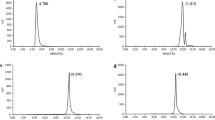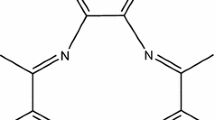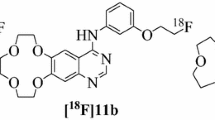Abstract
In this study, ethylene diamine tetraacetic acid-deoxyglucose (EDTADG) ligand was successfully synthesized and then radiolabeled with 99mTc directly to produce 99mTc-EDTADG with high radiochemical purity. 99mTc-EDTADG showed good in vitro stability. The partition coefficient and electrophoresis results showed it was hydrophilic and negatively charged. The biodistribution study in mice bearing S180 tumor showed that 99mTc-EDTADG had high accumulation in tumor tissue with high tumor-to-muscle and tumor-to-blood ratios. Single photon emission computed tomography imaging clearly visualized the tumor, suggesting it could be considered as a potential agent for tumor imaging.
Similar content being viewed by others
Avoid common mistakes on your manuscript.
Introduction
18F-2-fluoro-2-deoxy-d-glucose ([18F]FDG), an analogue of glucose, can enter the cell membrane using the same transporters as glucose. It is phosphorylated by hexokinase to 18F-FDG-6-phosphate. This metabolite does not undergo further metabolism and hence is trapped in the cell. Because of its property of trapping in the cells, [18F]FDG has been wildly used to diagnose cancer as a positron emission tomography (PET) radiopharmaceutical [1–4]. Although [18F]FDG is widely used in PET imaging for diagnosis of some kinds of tumor, the use of [18F]FDG for PET imaging in clinical practice is still limited by factors such as limited availability and high cost. Meanwhile, generator produced isotope, such as 99mTc, has inexpensive cost and suitable physical and chemical characteristics. Moreover, the availability of a generator and kit chemistry for preparing 99mTc radiopharmaceuticals may have a great impact on nuclear medicine. Thus, using 99mTc to label glucose derivatives is one of the major focuses of ongoing research. To date, some 99mTc labeled glucose derivatives have been synthesized and evaluated as tumor imaging agents [5–15]. Among them, 99mTc-ethylenedicysteine-deoxyglucose (99mTc-ECDG) exhibits the most promising property for tumor imaging and enters the Phase II clinical trial studies. However, the tumor-to-background ratio of 99mTc-ECDG is unsatisfactory. Therefore, further investigation to discover novel 99mTc labeled glucose analogues for tumor imaging is still necessary.
Because nonfunctionalized glucose compounds are generally weak ligands for complexing with 99mTc, structure modified with d-glucose or d-glucosamine was the reasonable way to develop new 99mTc labeled glucose derivatives as tumor imaging agents. It is known that ethylene diamine tetraacetic acid (EDTA) is a common and cheap chelator and can be used as a bifunctional chelating agent (BFCA) to form 99mTc complex on the basis of efficient binding of 99mTc to free carboxylic groups. The purpose of this study was to covalently couple EDTA bisanhydride with the free amino group of glucosamine to form the ethylene diamine tetraacetic acid-deoxyglucose (EDTADG) ligand and to evaluate the feasibility of 99mTc-EDTADG as a potential tumor imaging agent.
Experimental
Materials and methods
d-glucosamine hydrochloride was purchased from J&K CHEMICA, China. All other chemicals were of reagent grade and were used without further purification. 99Mo/99mTc generator was obtained from the China Institute of Atomic Energy (CIAE). IR spectrum was obtained with an AVATAR 360 FT-IR spectrometer using KBr pellets. NMR spectrum was recorded on a 400 MHz Bruker Avance spectrophotometer. ESI-MS spectrum was recorded on a LC–MS Shimadzu 2010 series. Elemental analyses were performed on a Vario EL elemental analyzer model. HPLC analysis was carried out with a reversed-phase column (Kromasil 100-5 μm, 250 × 4.6 mm), Shimadzu LC-20AT series.
Synthesis of EDTADG
215 mg d-glucosamine hydrochloride was dissovled in 3 mL water to a flask, and then 0.15 mL triethylamine was added. 128 mg ethylene diamine tetraacetic acid dianhydride was added into the solution successively and reacted in 50 °C oil bath for 6 h. The mixture was purified by chromatography on G15 Sephadex using water as eluent to obtain EDTADG water solution, and then the solid product (300 mg) was obtained by lyophilization.
The ligand EDTADG product was characterized by FT-IR (KBr), 400 M 1HNMR spectroscopy, ESI-MS and elemental analysis. The solvent of NMR spectrum analysis was D2O.
Radiolabeling of EDTADG and quality control techniques
25 mg of EDTADG was dissolved in 1 mL of saline in a 10 mL vial, then 50 μL of SnCl2·2H2O/HCl solution (4 mg SnCl2·2H2O/1 mL 1 N HCl) was added into the vial. After adjusting the pH of the above solution to 7–8 with NaOH solution, 1 mL of saline containing 99mTcO −4 (370 MBq) was added. Then the resulting solution was heated at 100 °C for 20 min. The radiochemical purity (RCP) of the product was identified by thin layer chromatography (TLC) by using a polyamide strip as a stationary phase and saline as eluent. High performance liquid chromatography (HPLC) analysis was carried out with a reversed-phase column (Kromasil 100-5 μm, 250 × 4.6 mm) on the Shimadzu LC-20AT at a flow rate of 1.0 mL/min. 10 % acetonitrile in a phosphate-buffered saline (pH 7.8) was used as the mobile phase.
In vitro stability study
The stability of the complex was assayed by measuring the RCP in the reaction mixture for 6 h at room temperature (25 °C). To estimate the serum stability of 99mTc-EDTADG, 0.1 mL of 99mTc-EDTADG was incubated in 0.6 mL of mouse serum at 37 °C for 4 h and then the RCP of the complex was analyzed by TLC.
Human serum albumin binding assay
10 µL of 99mTc-EDTADG (370 KBq) was added in 100 µL human serum albumin (100 mg/mL) in the centrifuge tube. After incubation at 37 °C for 2 h, the serum protein was precipitated by adding 1 mL trichloroacetic acid (250 mg/mL) to the mixture. The supernatant and precipitate were separated by centrifugation at 2000 g for 5 min. Then the radioactivity of each phase was measured separately. This experimental procedure was repeated three times and the percentage of human serum protein binding was determined as the following equation:
Determination of the partition coefficient
The partition coefficient was determined by mixing 99mTc-EDTADG with an equal volume of 1-octanol and phosphate buffer (0.025 mol/L, pH 7.4) in a centrifuge tube. The mixture was vortexed at room temperature for 1 min and then centrifuged at 5000×g for 5 min. From each phase 0.1 mL of the aliquot was pipetted and counted in a well γ-counter. Each measurement was repeated three times. The partition coefficient, P, was calculated using the following equation:
Usually the final partition coefficient value was expressed as log P.
Paper electrophoresis
1 μL of 99mTc-EDTADG was spotted at the center of the Whatman No. 1 chromatography paper strips (15 × 1 cm), which were impregnated with the phosphate buffer (0.025 mol/L pH 7.4). The analyses were carried out using phosphate buffer at 150 V for 2 h. The developed paper strips were dried, and the distribution of radioactivity on the strip was measured.
Cell uptake assay
To evaluate if the uptake of 99mTc-EDTADG in cells is mediated by means of a d-glucose mechanism, various concentrations of d-glucose (1 and 10 mg) was added to each culture tube that containing 8 mL (2 × 106 cells/mL) murine sarcoma S180 tumor cell suspension. After adding 99mTc-EDTADG, the mixtures were incubated during 2 h and the cells were centrifuged at 2000×g for 5 min. The supernatant was removed and the percentage of cell uptake is calculated as residue counts/total counts × 100 %.
Biodistribution study
In vivo growth was initiated by hypodermic injection of approximately 2 × 106 S180 cells into the left front leg of male mice. Over the course of 7 days, tumors grew to diameters of 10–15 mm. 0.1 mL of 99mTc-EDTADG (7.4 × 105 Bq) was injected into the mice bearing S180 tumor via a tail vein. The mice were sacrificed at 0.5, 2 and 4 h post-injection. The tumor, other organs of interest and blood were collected, weighed and measured for radioactivity. The results were expressed as the percent uptake of injected dose per gram of tissue (%ID/g). All biodistribution studies were performed in compliance with the national laws related to the conduct of animal experimentation.
SPECT image study
A dual-head single photon emission computed tomography (SPECT) (Skylight; Philips, Milpitas, CA, USA), using a low-energy parallel-hole collimator, was used for imaging studies. 0.1 mL of 99mTc-EDTADG (18.5 MBq) was injected intravenously through tail vein in mice (18–20 g) bearing S180 tumor. At 30 min after injection, the mice were anaesthetized with sodium pentobarbital for SPECT image study. Static images were acquired using 128 × 128 matrix for 20 min. The region of interest (ROI) between tumor tissue and contralateral muscle (background) was used to determine tumor-to-background ratio.
Results and discussion
Synthesis and radiolabeling
EDTADG was prepared by reacting d-glucosamine with ethylenediaminetetraacetic dianhydride in the presence of triethylamine. The reaction equation is shown in Scheme 1. It was characterized by IR, 1H NMR, Elemental analysis, MS. IR (KBr)/cm−1: 3336, 2975, 1384 (N–H); 3336 (O–H); 1633 (C = O); 1041 (C–O–C). 1HNMR (D2O), δ: 5.09 (d, J = 3.42 Hz, αH-1′a), 5.07 (d, J = 3.42 Hz, αH-1′b), 4.46 (d, J = 8.17 Hz, βH-1′), 3.81–3.52(m, 5H), 3.40 (s, 2H), 3.27–3.09 (m, 3H), 2.96 (s, 1H), 2.62–2.58(m, 1H). Elemental analysis: Anal. Calcd for C22H38N4O16·3H2O: C 39.75; H 7.16; N 8.06. Found: C 39.52; H 6.63; N 8.38. MS (ESI): m/z 615.3, [M + H]+.
The preparation of 99mTc-EDTADG was based on the reaction of [99mTcO4]− with EDTADG in the presence of stannous chloride as reducing agent to produce the final product. The RCP of 99mTc-EDTADG was more than 90 % by TLC. 99mTcO4 − and 99mTcO2.nH2O stayed at the origin spot while 99mTc-EDTADG migrated to R f = 0.8–1.0. The RCP of the complex was also checked by HPLC. The retention time of 99mTc-EDTADG was 2.9 min (Fig. 1), while that of 99mTcO4 − was found to be 5.8 min. A single product with high RCP (>95 %) was obtained.
Stability study
99mTc-EDTADG was stable over 6 h in the reaction mixture at room temperature. On the other hand, in mouse serum at 37 °C, the RCP of the complex was more than 90 % even up to 4 h after synthesis (Fig. 2), suggesting 99mTc-EDTADG had good in vitro stability.
Human serum albumin binding assay
As described in the experiment of human serum albumin binding assay [16, 17], the percentage of human serum protein binding ability for 99mTc-EDTADG was measured. The result showed that the percentage of human serum protein binding of 99mTc-EDTADG was 23.51 ± 1.14 %. It is pertinent to note that, when compared with 99mTc-CPADG (CPADG: 2-[(3-carboxy-1-oxopropyl)amino]-2-deoxy-d-glucose [14] ) (19.33 ± 2.86 %), there was no great difference between the two complexes (P > 0.05). Moreover, the percentage of human serum protein binding for 99mTc-EDTADG was much lower than the values of 99mTcN-PRODTC (PRODTC: proline dithiocarbamate, 87.42 ± 0.01 %) [16], 99mTcO-PHEDTC (PHEDTC: phenylalanine dithiocarbamate, 85.68 ± 0.61 %) [17] and 99mTcN-PHEDTC (86.32 ± 0.19 %) [17].
Partition coefficient (log P)
The log P value of 99mTc-EDTADG was found to be −2.54 ± 0.06, indicating it was hydrophilic. Moreover, 99mTc-EDTADG was more hydrophilic than 99mTc-CPADG (log P: −2.41), 99mTcN-DGDTC (DGDTC: deoxyglucose dithiocarbamate [11]) (log P: −1.30), 99mTc(CO)3-DGDTC (log P: −0.96) and 99mTcO-DGDTC (log P: −0.73). A higher hydrophilicity of 99mTc-EDTADG may possibly be related to its structure containing more sugar molecules.
Paper electrophoresis
Nearly 90 % of radioactivity of 99mTc-EDTADG was moved to anode, suggesting it was negative charged.
Cell uptake assay
In order to determine whether the uptake of 99mTc-EDTADG via glucose transport pathyway, we carried out the blocking experiment using d-glucose according to the Ref. [6]. Unfortunately, adding d-glucose at a concentration of 1 and 10 mg per tube, 99mTc-EDTADG showed similar or slightly higher tumor cell uptake at 1 and 10 mg d-glucose (0.89 ± 0.05 and 0.86 ± 0.08 %) than in glucose-free medium(0.76 ± 0.07 %). These results suggest that, although 99mTc-EDTADG is a glucose analogue, its uptake mechanism is not transported via the glucose transporters.
Biodistribution study
The result of biodistribution of 99mTc-EDTADG in mice bearing S180 tumor is shown in Table 1. Results of biodistribution of recently reported 99mTc labeled glucose analogues as tumor imaging agents are shown in Table 2 for comparison. As described in Table 1, the tumor uptakes of 99mTc-EDTADG are 2.25 ± 0.28, 1.11 ± 0.14, and 1.02 ± 0.13 % ID/g at 0.5, 2 and 4 h post-injection, respectively. The tumor-to-muscle ratio can maintain a high level (3.46, 2.96, 3.34 at 0.5, 2 and 4 h post-injection, respectively). The tumor-to-blood ratio increases with time and can reach 3.30 at 4 h post-injection because of the faster clearance of the blood. The kidney uptake is relatively high, suggesting the main routes of excretion is via the urinary tract. Low uptake in the stomach is suggestive of in vivo stability of 99mTc-EDTADG.
By comparison (Table 2), interestingly, among the five complexes, 99mTc-EDTADG is more hydrophilic than the others, thus possibly making the former much lower liver uptakes than the latter. Moreover, the lung and kidney uptakes of 99mTc-EDTADG are also lower so that a better target to non-target ratio may be obtained. Among them, the T/B ratio of 99mTc-EDTADG is the highest. From the above point of views, 99mTc-EDTADG shows the very promising properties as a potential tumor imaging agent.
SPECT image study
The SPECT imaging results showed the tumor uptake was visible (Fig. 3). The ROI ratio of 99mTc-EDTADG uptake for the tumor site versus the corresponding non-tumor region (T/NT ratio) was 2.79, suggesting it would be considered as a potential tumor imaging agent. The imaging findings were in keeping with the biodistribution results in mice. Better scintigraphic image should be acquired by using micro-SPECT on mice imaging in due course.
Conclusions
In summary, EDTADG ligand was successfully synthesized and its 99mTc complex was achieved in high yield. The high tumor localization, low background uptake, high tumor/blood and tumor/muscle ratios of the complex in mice exhibited promising properties, suggesting the possibility of 99mTc-EDTADG as a novel agent to target tumor.
References
Jaini S, Dadachova E (2012) FDG for therapy of metabolically active tumors. Semin Nucl Med 42:185–189
Yang DJ, Kong F-L, Oka T, Bryant JL (2012) Molecular imaging kits for hexosamine biosynthetic pathway in oncology. Curr Med Chem 19:3310–3314
Goreti RM, Falconer RA, Santos I (2013) Carbohydrate-based molecules for molecular imaging in nuclear medicine. Eur J Org Chem 2013:1401–1414
Sun YY, Chen Y (2009) Cancer drug development using glucose metabolism radiopharmaceuticals. Curr Pharm Des 15:983–987
Liu TL, Zhang JB, Wang XB, Yang JG, Tang ZG, Lu J (2014) Radiolabeled glucose derivatives for tumor imaging using SPECT and PET. Curr Med Chem 21:24–34
Yang DJ, Kim CG, Schechter NR, Azhdarinia A, Yu DF, Oh CS, Bryant JL, Won JJ, Kim EE, Podoloff DA (2003) Imaging with 99mTc ECDG targeted at the multifunctional glucose transport system: feasibility study with rodents. Radiology 226:465–473
Chen XJ, Li L, Liu F, Liu BL (2006) Synthesis and biological evaluation of technetium-99m-labeled deoxyglucose derivatives as imaging agents for tumor. Bioorg Med Chem Lett 16:5503–5506
Branco de Barros AL, Cardoso VN, Mota LdG, Leite EA, de Oliveira MC, Alves RJ (2010) A novel d-glucose derivative radiolabeled with technetium-99m: synthesis, biodistribution studies and scintigraphic images in an experimental model of Ehrlich tumor. Bioorg Med Chem Lett 20:2478–2480
Chen Y, Huang ZW, He L, Zheng SL, Li JL, Qin DL (2006) Synthesis and evaluation of a technetium-99m-labeled diethylenetriaminepentaacetate–deoxyglucose complex ([99mTc]-DTPA-DG) as a potential imaging modality for tumors. Appl Radiat Isot 64:342–347
Fernandez S, Crocamo N, Incerti M, Giglio J, Scarone L, Rey A (2012) Preparation and preliminary bioevaluation of a 99mTc(CO)3-glucose derivative prepared by a click chemistry route. J Label Compd Radiopharm 55:274–280
Zhang JB, Ren JL, Lin X, Wang XB (2009) Synthesis and biological evaluation of a novel 99mTc nitrido radiopharmaceutical with deoxyglucose dithiocarbamate, showing tumor uptake. Bioorg Med Chem Lett 19:2752–2754
Lin X, Jin ZH, Ren JL, Pang Y, Zhang WF, Huo JF, Wang XB, Zhang JB, Zhang YY (2012) Synthesis and biodistribution of a new 99mTc-oxo complex with deoxyglucose dithiocarbamate for tumor imaging. Chem Biol Drug Des 79:239–245
Lin X, Chao XY, Zhang JB, Jin ZH, Zhang YY (2014) Preparation and biodistribution of a 99mTc tricarbonyl complex with deoxyglucose dithiocarbamate as a tumor imaging agent for SPECT. Bioorg Med Chem Lett 24:3964–3967
Wang Y, Zhu JJ, Song XQ, Wang XB, Yang JG, Zhang JB (2014) Synthesis and evaluation of 99mTc-2-[(3-carboxy-1-oxopropyl)amino]-2-deoxy-d-glucose as a potential tumor imaging agent. Bioorg Med Chem Lett 24:3882–3885
Liu LQ, Zhao MC, Wang Z, Qin YY, Wang XB (2014) Synthesis and biological evaluation of novel technetium-99m-labeled HYNIC-d-glucose as a potential tumor imaging agent. J Radioanal Nucl Chem 301:731–737
Liu M, Lin X, Song XQ, Cui Y, Li PW, Wang XB, Zhang JB (2013) Synthesis and biodistribution of a novel 99mTc nitrido radiopharmaceutical with proline dithiocarbamate as a potential tumor imaging agent. J Radioanal Nucl Chem 298:1659–1663
Zhu JJ, Wang Y, Li ZX, Fang SA, Zhang JB (2014) Synthesis and biological evaluation of novel 99mTc-oxo and 99mTc-nitrido complexes with phenylalanine dithiocarbamate for tumor imaging. J Radioanal Nucl Chem 302:211–216
Acknowledgments
The work was financially supported, in part, by National Natural Science Foundation of China (21171024, 81101069), Beijing Natural Science Foundation (7112035).
Author information
Authors and Affiliations
Corresponding author
Rights and permissions
About this article
Cite this article
Wang, Y., Song, X. & Zhang, J. Synthesis and evaluation of a 99mTc-labeled deoxyglucose derivative as a potential agent to target tumor. J Radioanal Nucl Chem 306, 477–482 (2015). https://doi.org/10.1007/s10967-015-4109-2
Received:
Published:
Issue Date:
DOI: https://doi.org/10.1007/s10967-015-4109-2








